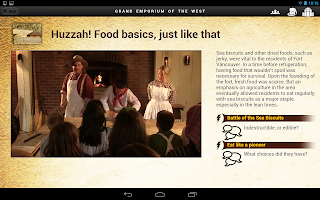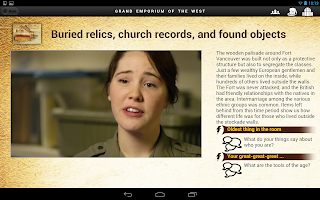We are less than a month away from the release of our latest NEH-funded mobile app; this one titled "The Grand Emporium of the West."
This app is designed for tablet computers, and it is designed for use in middle school history classes nationwide.
It continues the story of Fort Vancouver, but instead of being locative in nature, it is designed as a place-less prompting tool for classroom activities and discussions about the 19th-century frontier, wherever you are in the United States.
We have an introduction to the app, that sets the scene and provides some context about Fort Vancouver (but also can be skipped). Here are a few screenshots of that segment:
So the image you see there is a colorized version (by our multimedia designer Marsha Matta) of a historic sketch, and then we took the color away from anything that wasn't touchable, to create the main app interface:
Each colorized section, when touched, opens a prompting box, and within each box is a section of contextual information, a multimedia object (usually a video), and two suggested activities, plus two suggested discussion prompts. Those pages look like this:
And so forth ... When you touch one of the brown bars, or discussion bubbles, an interior box appears that provides a specific prompt (with a guide box also available for teachers looking to align with history thinking standards). That interior box looks like this:
Inside each interior box is a chance to collaborate, through Google Docs, as a way to share files, ideas, etc. ...
This app will be free and available for both Apple and Android devices; any history teachers out there want to give it a try, please let me know.












